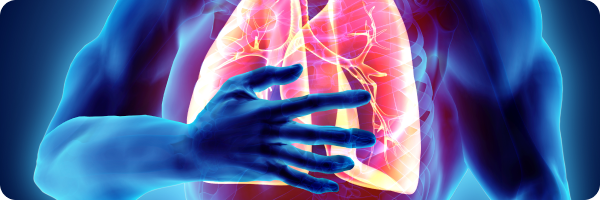The connection between digestion and breathing might not be obvious, but for people with asthma or COPD, when and how you eat can affect your symptoms.
This article explores how meal timing, reflux, and eating habits can influence your lung health, and what strategies you can safely try to improve your symptoms.
Why digestion impacts breathing in asthma and COPD
Your lungs and stomach are close neighbours – and sometimes, they interfere with each other. Digestion and breathing may seem like separate systems, but they’re more connected than you might think.
- Meal timing and portion size can influence pressure in the abdomen, which can affect how easily your diaphragm moves – this is especially important in COPD, where the lungs and diaphragm already work harder to function. If you’ve ever felt breathless or tight-chested after eating, this could be part of the reason.
- High-fat or large meals can also increase inflammation in the airways and make it harder to breathe comfortably.
- Acid reflux (also known as heartburn) can irritate the airways and trigger cough, wheeze, or breathlessness and subsequent inflammation may worsen asthma and COPD control.
What is Gastro-oesophageal Reflux (GORD) and how does it impact lung symptoms?

Gastro-oesophageal reflux disease (GORD or GERD) happens when stomach acid flows back up into the food pipe (oesophagus), causing heartburn or a burning sensation in the chest.
GORD is more common in people with asthma and COPD, and it can make breathing problems worse and in the case of COPD studies have found that associations between GORD and an increased risk of COPD exacerbations and hospitalisations.
This can happen in several possible ways:
- The acid may irritate the airway, causing tightening of the muscles around the lungs.
- Small amounts of acid may be inhaled into the lungs (called micro-aspiration), which increases inflammation.
- Nerves in the oesophagus and lungs may become more reactive, making airways twitchier and more prone to spasm.
A typical approach to managing reflux symptoms involves a combination of lifestyle changes, dietary adjustments, and medications where needed.
1. Lifestyle and behavioural changes
- Weight management: Losing excess weight can significantly reduce reflux.
- Elevate the head of the bed: Raising the head by 15–20 cm can help prevent night-time reflux.
- Stop smoking: Smoking weakens the lower oesophageal sphincter.
2. Dietary changes
- Identify and avoid trigger foods: Common triggers include fatty foods, caffeine, alcohol, chocolate, citrus, and spicy foods.
- Eat smaller meals more frequently: Avoid large or heavy meals that distend the stomach.
- Stay upright after meals: Wait at least 2–3 hours before lying down or going to bed. Encourages digestion and reduces pressure on the stomach.
3. Medications (if needed)
- Antacids: Provide quick relief by neutralising stomach acid.
- Proton Pump Inhibitors (PPIs, e.g. omeprazole): More effective at reducing acid for moderate to severe reflux.
- H2 Blockers: Refuce the amount of acid your stomach produces
- Alginates (e.g. Gaviscon): Form a barrier to help stop acid rising.
4. Monitoring and further investigation
- If symptoms persist despite lifestyle and medication, referral for further tests may be needed which may include:
- endoscopy/gastroscopy – a camera investigation of the lining of the oesophagus (food pipe) and stomach
- breath or stool test for an overgrowth of helicobacter pylori bacteria
- For people with asthma or COPD, managing reflux may also improve lung symptoms.
A note on medical treatment
Treating acid reflux (GORD) with medicine may slightly improve lung function in people with asthma and help reduce how often they need their reliever inhaler. However, it’s still unclear whether this treatment helps with asthma flare-ups, symptoms, or the need to see a doctor or go to hospital.
In COPD more research is needed to determine the long term impact and safety of PPI medication use in COPD as whilst there’s early evidence that PPIs might help reduce COPD flare-ups, other research has indicated these medications may in fact worsen exacerbations and outcomes in COPD over time. It’s important to discuss with your doctor what is the right strategy for you.
Managing reflux through dietary and lifestyle strategies is considered a safe way to manage your reflux symptoms and potentially improve your breathing symptoms. Even if you don’t currently have reflux symptoms, some of the dietary strategies discussed in more detail below may still benefit your breathing and lung health, so it’s worth trying them out to see what works for you.
This is a general guide and should not replace personalised medical advice. If your symptoms are frequent, severe, or getting worse – such as ongoing heartburn, regurgitation, coughing after eating, difficulty swallowing, chest pain, or unexplained weight loss – please speak to your GP or a specialist for further assessment.
Avoiding trigger foods

Avoiding trigger foods is an important step in managing reflux symptoms, especially for people with asthma or COPD, where reflux can worsen breathing. Certain foods are more likely to relax the lower oesophageal sphincter (the valve between the stomach and oesophagus) or increase stomach acid, making reflux more likely.
Common triggers include:
- spicy foods
- fatty or fried foods
- chocolate
- caffeine
- alcohol
- citrus fruits
- tomatoes
- peppermint
- carbonated drinks
However, not everyone reacts to the same foods, so it’s helpful to keep a food and symptom diary to spot personal triggers. Reducing or eliminating foods that you identify as triggers – especially in the evening or before lying down – can help reduce reflux episodes and protect both digestive and lung health.
Heavy meals and post-meal breathlessness

Large, rich meals can make breathing feel harder – especially for people with COPD or severe asthma. That’s because in COPD, the lungs often become overinflated (a condition called lung hyperinflation), which pushes down on the diaphragm and leaves less room for your stomach to expand. When you eat a big meal, your stomach stretches and presses upward, further limiting the space your lungs need to move freely.
This pressure can lead to uncomfortable symptoms like:
- Bloating
- Feeling overly full
- Slower, shallower breathing
- Chest tightness
- Shortness of breath after eating
These effects are even more noticeable if the meal is high in fat. Fatty foods tend to slow down digestion, meaning food sits in the stomach for longer – increasing pressure on the diaphragm and worsening discomfort. This can lead to a vicious cycle of discomfort, reduced appetite, and poor nutrition, all of which can affect your energy levels and breathing over time.
Try this instead:
– Eat smaller meals more frequently throughout the day rather than three large meals.
– Avoid heavy, greasy, or fatty foods, especially close to bedtime or physical activity.
– Take your time while eating, chew thoroughly, and avoid lying down immediately after meals.
– Consider keeping a food and symptom diary to track which meals make you feel more breathless.
Late-night eating and lung symptoms

Eating a large meal shortly before bed can make night-time asthma or COPD symptoms worse – especially if reflux is part of the picture. This is because when you lie down soon after eating, gravity is no longer helping to keep food and stomach acid where they belong. Instead, acid can flow back up into the oesophagus (food pipe), a problem known as gastro-oesophageal reflux disease (GORD).
For people with asthma, this reflux can irritate the airways and trigger symptoms like:
- Coughing at night
- Wheezing
- Shortness of breath or tight chest that wakes you up
In people with COPD, reflux at night can also increase breathlessness and make it harder to get good quality sleep – which in turn affects energy levels, mood, and daytime symptoms.
This issue is recognised in national guidance. NICE (National Institute for Clinical Excellence) recommends that people with reflux:
- Avoid eating large meals late at night
- Finish their evening meal at least 3 to 4 hours before lying down
- Consider raising the head of the bed slightly (using bricks or sturdy blocks under the bed legs) to prevent stomach acid moving upwards during the night
What you can do:
– Aim to finish your last meal at least 2-3 hours before going to bed
– Avoid high-fat, spicy, or acidic foods in the evening
– Stay upright after eating – try light activity like walking or gentle tidying instead of lying on the sofa
– If night-time reflux is a regular issue, speak to your GP for further support
By making a few small changes to your evening routine, you may notice improvements in both your sleep quality and your breathing.
Intermittent fasting and lung health

Intermittent fasting (IF) – sometimes also called Time-Restricted Eating (TRE) – has gained popularity for its potential health benefits, including reducing inflammation and improving metabolic health. But what does it mean, and is it safe or useful for people with asthma or COPD?
🔍 What is Intermittent Fasting?
Intermittent fasting isn’t about what you eat, but when. It includes different patterns, such as:
- Simple TRE (Time-Restricted Eating): e.g. finishing your last meal 3–4 hours before bedtime, or following a consistent daily eating window like 10am–6pm.
- More structured IF patterns: e.g. the 16:8 method (16 hours fasting, 8 hours eating), or alternate day fasting.
These approaches aim to give the body longer periods of rest from digestion, which may influence inflammation and metabolism.
🔬 What we know so far:
- Some studies in healthy people have shown that intermittent fasting can reduce inflammatory markers like CRP(C-reactive protein) and IL-6 (interleukin-6), which are also involved in airway inflammation.
- A 2019 review suggested that fasting may hypothetically benefit people with asthma, by improving metabolic markers and reducing systemic inflammation – but direct studies in asthma or COPD are currently lacking.
- In animal models, some positive respiratory effects have been observed, but this doesn’t yet translate into firm advice for humans with lung conditions.
🚦 Is it safe for people with asthma or COPD?
Currently, intermittent fasting is not routinely recommended as a treatment for asthma or COPD – particularly:
- In older adults, where there’s a risk of frailty or unintentional weight loss
- For people with COPD, where maintaining a stable weight and good nutritional intake is essential to support breathing and muscle strength
Try this instead:
A safer starting point for most people with asthma or COPD is simply
If you’re interested in trying a form of intermittent fasting for other health reasons, speak to a healthcare professional or dietitian first. They can help you find an approach that supports your lung health, nutrition, and energy needs.
✅ Safe eating habits for lung health
| Habit | Why it helps |
|---|---|
| Maintain a healthy weight | Helps ease breathing and reduce reflux risk |
| Identify reflux triggers | Common ones include caffeine, alcohol, chocolate, and spicy foods |
| Eat smaller meals | Reduces pressure on the diaphragm and bloating |
| Sit upright after meals | Helps digestion and reduces acid reflux |
| Avoid late-night eating | Reduces risk of reflux-related symptoms |
Final thoughts: Small changes, big breathing gains
Your lungs and digestive system may be closer allies than you think – and taking simple steps to improve how and when you eat could help you breathe easier. Whether it’s avoiding heavy meals before bed, identifying trigger foods, or spacing out your eating times, these small daily shifts can support both your gut and lung health. Every meal is an opportunity to reduce inflammation, ease reflux, and reclaim comfort. Try one strategy at a time, listen to your body, and remember: even small changes can make a real difference to your breathing, energy, and quality of life.
If you haven’t already, download the free Evergreen Life app to track your health, including managing your asthma and/or COPD, and get practical tips that help you take control of your overall health.
This article is intended for general information and education purposes only. It does not constitute personal medical advice or a clinical recommendation. While the information presented draws on reputable sources and research, the guidance may not be appropriate for everyone.
Eating patterns, reflux symptoms, and their impact on lung health can vary widely from person to person. Some people with asthma, COPD, or overlapping respiratory conditions may also have co-existing gastrointestinal or metabolic conditions (such as diabetes, gastroparesis, or obesity-related complications), which require tailored medical management.
If you experience the following, it is important to seek medical advice:
– Persistent reflux symptoms (e.g., heartburn, regurgitation, or food sticking)
– Unexplained weight loss
– Difficulty swallowing
– Cough that wakes you at night or worsens after meals
– Recurrent chest infections
– Wheezing not responding to asthma treatment
– Breathlessness after eating
Please speak to your GP, practice nurse, or respiratory specialist before making significant dietary or medication changes. If you have known reflux or a condition like GORD (gastro-oesophageal reflux disease), you may need diagnostic tests, acid suppression therapy, or referral to a specialist.
🔴 Call 999 or seek urgent medical help if you develop severe chest pain, choking, vomiting blood or black stools, or sudden shortness of breath after eating or drinking.
You can also contact:
– NHS 111 (in the UK) for urgent but non-life-threatening concerns
– Your local GP practice for tailored advice and review
-A registered dietitian with expertise in respiratory and gastrointestinal health for nutrition support
Finally, please remember: while lifestyle changes like adjusting meal timing and composition can support your overall respiratory health, they are not a substitute for prescribed asthma or COPD medication.
- Barros R, Moreira A, Padrão P, Teixeira VH, Carvalho P, Delgado L, Lopes C, Severo M, Moreira P. Dietary patterns and asthma prevalence, incidence and control. Clin Exp Allergy. 2015 Nov;45(11):1673-80. doi: 10.1111/cea.12544. PMID: 25818037.
- Barros, Renata & Moreira, A & Padrão, Patrícia & Teixeira, Vitor & Carvalho, Pedro & Delgado, Luís & Lopes, Carla & Severo, Milton & Moreira, Pedro. (2015). Dietary patterns and asthma prevalence, incidence and control. Clinical & Experimental Allergy. 10.1111/cea.12544.
- Benson, Victoria & Müllerová, Hana & Vestbo, Jørgen & Wedzicha, Jadwiga & Patel, Anant & Hurst, John. (2015). Associations between gastro-oesophageal reflux, its management and exacerbations of chronic obstructive pulmonary disease. Respiratory medicine. 109. 10.1016/j.rmed.2015.06.009.
- Broers C, Tack J, Pauwels A. Review article: gastro-oesophageal reflux disease in asthma and chronic obstructive pulmonary disease. Aliment Pharmacol Ther. 2018 Jan;47(2):176-191. doi: 10.1111/apt.14416. Epub 2017 Nov 29. PMID: 29193245.
- de Cabo, R., & Mattson, M. P. (2019, December 25). Effects of intermittent fasting on health, aging, and disease. New England Journal of Medicine, 381(26), 2541–2551.
- Janetzki, Jack & Sykes, Matthew & Ward, Michael & Pratt, Nicole. (2021). Proton pump inhibitors may contribute to progression or development of chronic obstructive pulmonary disease—A sequence symmetry analysis approach. Journal of Clinical Pharmacy and Therapeutics. 46. 10.1111/jcpt.13520.
- Kikuchi S, Imai H, Tani Y, Tajiri T, Watanabe N. Proton pump inhibitors for chronic obstructive pulmonary disease. Cochrane Database Syst Rev. 2020 Aug 25;8(8):CD013113. doi: 10.1002/14651858.CD013113.pub2. PMID: 32844430; PMCID: PMC8188959.
- Kopsaftis Z, Yap HS, Tin KS, Hnin K, Carson-Chahhoud KV. Pharmacological and surgical interventions for the treatment of gastro‐oesophageal reflux in adults and children with asthma. Cochrane Database of Systematic Reviews 2021, Issue 5. Art. No.: CD001496. DOI: 10.1002/14651858.CD001496.pub2. Accessed 25 September 2025.
- Lisa G. Wood, Manohar L. Garg, Peter G. Gibson, A high-fat challenge increases airway inflammation and impairs bronchodilator recovery in asthma, Journal of Allergy and Clinical Immunology, Volume 127, Issue 5, 2011, Pages 1133-1140, ISSN 0091-6749.
- Lugogo, Njira & Kreindler, James & Martin, Ubaldo & Cook, Bill & Hirsch, Ian & Trudo, Frank. (2020). Blood Eosinophil Count Group Shifts and Kinetics in Severe, Eosinophilic Asthma. Annals of Allergy, Asthma & Immunology. 125. 10.1016/j.anai.2020.04.011.
- Mulas A, Cienfuegos S, Ezpeleta M, Lin S, Pavlou V, Varady KA. Effect of intermittent fasting on circulating inflammatory markers in obesity: A review of human trials. Front Nutr. 2023 Apr 17;10:1146924. doi: 10.3389/fnut.2023.1146924. PMID: 37139450; PMCID: PMC10149732.
- NICE. (2019). Gastro-oesophageal reflux disease and dyspepsia in adults: Investigation and management. (Clinical guideline CG184). (Published 3 September 2014).
- Patient.info. (2023, August 10). Antacids: what are they and how do they work?. (Peer reviewed by Dr Doug McKechnie; updated by Dr Surangi Mendis).
- Patient.info. (2024, July 4). Gastroscopy (Endoscopy). (Peer reviewed by Dr Hayley Willacy; updated by Dr Philippa Vincent).
- Patient.info. (2024, October 21). Helicobacter pylori. (Peer reviewed by Dr Colin Tidy; updated by Dr Hayley Willacy).
- Patient.info. (2024, October 21). Proton pump inhibitors: uses and side-effects. (Peer reviewed by Dr Toni Hazell; updated by Dr Philippa Vincent).
- Real-Hohn A, Navegantes C, Ramos K, Ramos-Filho D, Cahuê F, Galina A, Salerno VP. The synergism of high-intensity intermittent exercise and every-other-day intermittent fasting regimen on energy metabolism adaptations includes hexokinase activity and mitochondrial efficiency. PLoS One. 2018 Dec 21;13(12):e0202784. doi: 10.1371/journal.pone.0202784. PMID: 30576325; PMCID: PMC6303071.
- Tan J, Li L, Huang X, et al. Associations between gastro-oesophageal reflux disease and a range of diseases: an umbrella review of systematic reviews and meta-analyses. BMJ Open 2020;10:e038450. doi: 10.1136/bmjopen-2020-038450.
- Vitacca, Michele & Callegari, Gregorio & Sarvà, Maria & Bianchi, Luca & Barbano, Luca & Balbi, Bruno & Ambrosino, Nicolino. (2005). Physiological effects of meal in difficult-to wean tracheotomised patients with chronic obstructive pulmonary disease. Intensive Care Medicine. 31. 236-242. 10.1007/s00134-004-2530-z.





